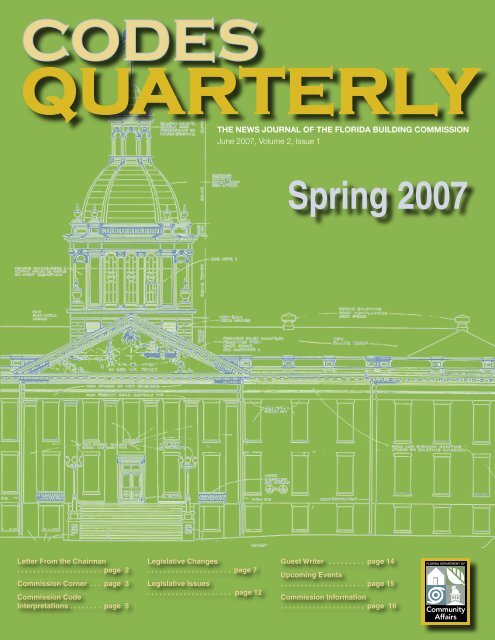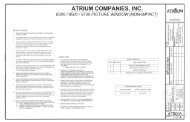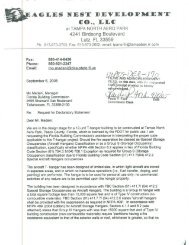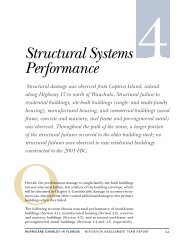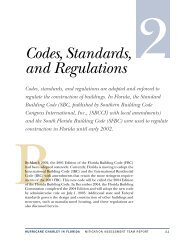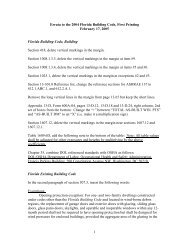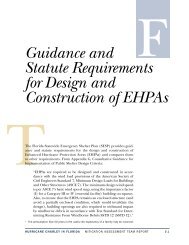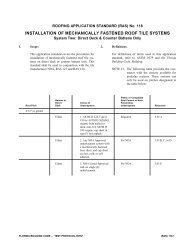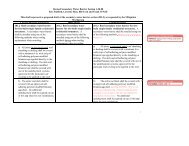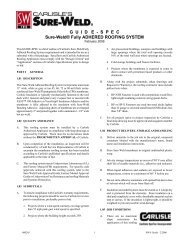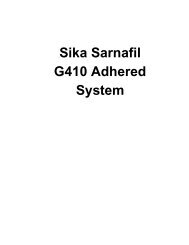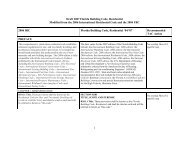Codes and Standards - Florida Building Code Information System
Codes and Standards - Florida Building Code Information System
Codes and Standards - Florida Building Code Information System
You also want an ePaper? Increase the reach of your titles
YUMPU automatically turns print PDFs into web optimized ePapers that Google loves.
CODES<br />
QUARTERLY<br />
THE NEWS JOURNAL OF THE FLORIDA BUILDING COMMISSION<br />
June 2007, Volume 2, Issue 1<br />
Letter From the Chairman<br />
. . . . . . . . . . . . . . . . . . . . . page 2<br />
Commission Corner . . . page 3<br />
Commission <strong>Code</strong><br />
Interpretations . . . . . . . . page 5<br />
Legislative Changes<br />
. . . . . . . . . . . . . . . . . . . . . page 7<br />
Legislative Issues<br />
. . . . . . . . . . . . . . . . . . . . . page 12<br />
Spring 2007<br />
Guest Writer . . . . . . . . . page 14<br />
Upcoming Events<br />
. . . . . . . . . . . . . . . . . . . . . page 15<br />
Commission <strong>Information</strong><br />
. . . . . . . . . . . . . . . . . . . . . page 16<br />
FLORIDA DEPARTMENT OF<br />
Community<br />
Affairs
Considering the 1997 Legislature’s interest in building<br />
codes as a policy tool, it is appropriate to reflect on<br />
how balance is maintained among major state policies<br />
implemented through the <strong>Florida</strong> <strong>Building</strong> <strong>Code</strong>.<br />
The law [s. 553.72(1), F.S.] establishing the <strong>Florida</strong> <strong>Building</strong><br />
<strong>Code</strong> indicates its intent to provide for effective <strong>and</strong><br />
reasonable protection of the public safety, health <strong>and</strong> welfare<br />
at the most reasonable cost. The law further specifies that<br />
the <strong>Code</strong> is “primarily for public health <strong>and</strong> life safety <strong>and</strong><br />
secondarily for protection of property.” These principles reflect<br />
traditional consensus on the purpose of building code regulations.<br />
However, as this recent legislative session reminds us,<br />
lawmakers also consider the <strong>Code</strong> an effective tool for other<br />
public welfare policies.<br />
The need for energy independence <strong>and</strong> the problem of<br />
global warming led to energy conservation initiatives. Hurricane<br />
threats to the property insurance market <strong>and</strong> the state<br />
economy led to calls for more aggressive structural codes for<br />
both new <strong>and</strong> existing buildings.<br />
The risk in increasing our reliance on the <strong>Code</strong> as a tool to<br />
implement policy is that the politics of government can interfere<br />
with the deliberative processes essential to maintaining an<br />
effective balance among multiple state policies.<br />
The need for policy makers to quickly react to crises leads<br />
to a narrowed legislative focus <strong>and</strong> setting priorities that can<br />
distort the balance. During crises or perceived crises, proposals<br />
for regulatory action can be gr<strong>and</strong>, <strong>and</strong> in some cases extreme.<br />
Consider an early legislative proposal to require installation<br />
of shutters or impact windows throughout the state when a<br />
building permit is issued for any kind of work on an existing<br />
building. In less reactive times, more consideration would be<br />
given to the cost to the homeowner <strong>and</strong> the balance of cost<br />
increases for property protection, energy efficiency <strong>and</strong> home<br />
safety requirements.<br />
Affordable housing has traditionally been given greater<br />
consideration, compared to other perceived critical needs, than<br />
it currently does. In many areas of the state, affordable housing<br />
is insufficient for the workforce. Property values, taxes <strong>and</strong><br />
insurance increases place home ownership beyond the reach<br />
of many workers. As costs mount, some interests advocate<br />
Letter From The Chairman<br />
Question of Balance<br />
increasing the cost of construction to offset the costs of operation<br />
<strong>and</strong> insuring homes. When government makes such<br />
decisions for its citizens via regulation, there must be a balance<br />
established between societal interests <strong>and</strong> individual interests.<br />
<strong>Florida</strong>’s Energy <strong>Code</strong> is a model for how societal interest<br />
policies can be balanced with the individual’s ability to<br />
bear the costs of regulation. When the code was established<br />
by law in the late 1970s, the means to maintain balance was<br />
also established [s.553.901, F.S.]. Energy <strong>Code</strong> requirements<br />
must be cost-effective for the consumer. This criterion is not<br />
generally applied to building code life safety requirements, but<br />
is appropriate for policies primarily directed to societal welfare<br />
<strong>and</strong> property protection.<br />
Those who advocate property protection to mitigate hurricane-related<br />
damage have proposed that the state optimize<br />
minimum construction regulations based on st<strong>and</strong>ardized cost/<br />
benefit considerations. The Legislature previously addressed<br />
costs <strong>and</strong> benefits, revising the state property protection policy<br />
as it relates to hurricane resistance. It amended the building<br />
code law to explicitly recognize mitigation of property damage<br />
due to windstorms as an objective of the <strong>Code</strong>, <strong>and</strong> directed<br />
the Commission to consider measurable benefits relative to<br />
costs for <strong>Code</strong> requirements that benefit property protection<br />
but not life safety. The Legislature also established a specific<br />
increased cost limit for required hurricane protection retrofits<br />
when existing homes are re-roofed [HB 7057].<br />
The Commission, as steward of the <strong>Florida</strong> <strong>Building</strong> <strong>Code</strong>,<br />
must also consider the impacts of the <strong>Code</strong> on housing affordability<br />
<strong>and</strong> other state policies. The policy makers respond to<br />
immediate crises <strong>and</strong> set priorities through directives to the<br />
Commission. However, it is the Commission’s responsibility to<br />
maintain continuity <strong>and</strong> balance among all established policies<br />
while responding to the priorities. Consistency <strong>and</strong> balance<br />
may not result in the responses desired by advocates of individual<br />
policies, but they are fundamental to the stable regulatory<br />
environment essential for long-term progress in achieving<br />
a better built environment for <strong>Florida</strong>.<br />
Raul L. Rodriguez, AIA, is president of Rodriguez <strong>and</strong><br />
Quiroga Architects Chartered, in Coral Gables.<br />
Stronger <strong><strong>Code</strong>s</strong> Through Science <strong>and</strong> Consensus
Note: This edition of <strong><strong>Code</strong>s</strong> Quarterly marks<br />
the change in administration of <strong>Florida</strong><br />
government by shifting emphasis in content to<br />
underscore the <strong>Florida</strong> <strong>Building</strong> Commission’s<br />
role in promoting uniformity <strong>and</strong> consistency<br />
regarding technical requirements <strong>and</strong><br />
enforcement. We believe the changes will help<br />
local governments, industry <strong>and</strong> consumers<br />
better underst<strong>and</strong> the <strong>Code</strong> <strong>and</strong> the work of<br />
the Commission.<br />
The <strong>Florida</strong> <strong>Building</strong> Commission<br />
has been busy in recent months<br />
working on the next edition of<br />
the <strong>Florida</strong> <strong>Building</strong> <strong>Code</strong>, a rule for<br />
product approval <strong>and</strong> several legislative<br />
assignments. This article is dedicated to<br />
recapping tasks from the previous reporting<br />
period <strong>and</strong> identifying new ones for<br />
the coming quarter.<br />
The Commission’s principal task is development<br />
of the 2007 Edition of the<br />
<strong>Florida</strong> <strong>Building</strong> <strong>Code</strong> (the <strong>Code</strong>). The<br />
Commission selected the 2006 Edition<br />
of the International <strong><strong>Code</strong>s</strong> as the foundation<br />
for the state <strong>Code</strong>, <strong>and</strong> proposals<br />
for <strong>Florida</strong>-specific modifications were<br />
due January 1, 2007. In mid-March, the<br />
Commission’s Technical Advisory Committees<br />
reviewed the proposals <strong>and</strong> developed<br />
recommendations for consideration<br />
at the June 27 meeting. A decision on the<br />
proposals will be made at a workshop held<br />
during this meeting, <strong>and</strong> the 2007 <strong>Code</strong><br />
will be finalized at the August 22 meeting.<br />
<strong>Code</strong> books are scheduled to be available<br />
by January 1, 2008, <strong>and</strong> the new <strong>Code</strong> will<br />
take effect on October 1, 2008. <strong>Information</strong><br />
on the proposals can be found at the<br />
Commission’s website under <strong>Code</strong> Modifications.<br />
Hurricane protection activities were also a<br />
major focus during the Winter-Spring of<br />
2007. The 2006 Supplement to the 2004<br />
<strong>Code</strong>, effective December 23, 2006, imple-<br />
Commission Corner<br />
mented a number of enhancements including<br />
additional requirements for roofing<br />
<strong>and</strong> substantial upgrades for residential<br />
structural requirements. The highest profile<br />
issue, however, was windborne debris<br />
protection. The 2005 Legislature directed<br />
the Commission to review the effects of<br />
Hurricane Ivan with building officials<br />
from the <strong>Florida</strong> Panh<strong>and</strong>le [Section 39,<br />
Roof damage from hurricane-force winds in a <strong>Florida</strong> community.<br />
SB 442]. The review revealed that windborne<br />
debris was not a significant cause of<br />
damage, but also determined that Ivan was<br />
not a “<strong>Code</strong> design storm” as identified<br />
by ASCE 7 <strong>and</strong> the <strong>Code</strong>. In light of this<br />
<strong>and</strong> the damage to South <strong>Florida</strong> from<br />
Hurricane Charley -- which was a “<strong>Code</strong><br />
design storm” -- building officials <strong>and</strong><br />
stakeholder industries agreed to further<br />
assess windborne debris risk via a wind<br />
tunnel <strong>and</strong> computer simulation study.<br />
ASCE 7 <strong>and</strong> the <strong>Code</strong> currently account<br />
for treed terrain effects by reducing required<br />
design wind pressures at given wind<br />
speeds, <strong>and</strong> the first phase of the study<br />
indicated that temperate zone forests,<br />
characteristic of North <strong>Florida</strong>, have a major<br />
impact on windborne debris risk <strong>and</strong><br />
should also be accounted for in building<br />
st<strong>and</strong>ards. The Commission adopted the<br />
researchers’ recommendation to increase<br />
The News Journal of the <strong>Florida</strong> <strong>Building</strong> Commission - Spring 007<br />
windborne debris protection requirements<br />
for the Panh<strong>and</strong>le region from those areas<br />
within one mile of the coast to areas with<br />
130 mph <strong>and</strong> higher design wind speeds<br />
[ARA Report]. However, during the January<br />
2007 special session on insurance, the<br />
Legislature superceded the 130 mph <strong>and</strong><br />
higher st<strong>and</strong>ard by adopting the 120 mph<br />
<strong>and</strong> higher wind speed requirement that<br />
applies throughout the rest of the state.<br />
Lawmakers also moved the date for eliminating<br />
the indoor pressure design option<br />
for windborne debris protection from the<br />
effective date for the 2007 <strong>Code</strong> to immediate<br />
elimination [HB 1-A]. That date was<br />
subsequently moved to June 1, 2007, during<br />
the regular legislative session [Section<br />
26, SB 2498].<br />
Wind tunnel testing conducted during the<br />
windborne debris study indicated ASCE 7<br />
may under-predict wind pressures on roofs<br />
of buildings located in open terrain, such<br />
as that in South <strong>Florida</strong>. The second phase<br />
of the windborne debris study focused on<br />
developing more accurate pressure coefficients<br />
for the design procedure. The Legislature<br />
directed the Commission to help<br />
Citizens Insurance, the state-backed insur-<br />
continue to page 4<br />
ÑÑ
Commission Corner, continue from page 3<br />
ance provider, establish insurance qualifying<br />
criteria for buildings built within 2,500<br />
feet of the coast after 2009. A portion of<br />
the research was redirected to developing<br />
the basis for these criteria.<br />
The Commission continued efforts to address<br />
building officials’ concerns with the<br />
difficulty of enforcing <strong>Code</strong> requirements<br />
for windows, shutters <strong>and</strong> garage doors.<br />
The 2004 hurricanes revealed significant<br />
problems with water intrusion <strong>and</strong> wind<br />
pressure-related performance of building<br />
components <strong>and</strong> cladding. St<strong>and</strong>ards <strong>and</strong><br />
evaluation/certification programs have<br />
been in place for a number of years for<br />
windows, shutters <strong>and</strong> garage doors, so<br />
attention turned to improving the linkage<br />
between product evaluation <strong>and</strong> acceptance<br />
<strong>and</strong> the approval of installed products<br />
through the <strong>Code</strong> enforcement process.<br />
<strong>Building</strong> officials wanted a better way<br />
to determine that the component installed<br />
is the one for which code compliance has<br />
been demonstrated through the evaluation<br />
<strong>and</strong> acceptance part of the product approval<br />
process. Manufacturers <strong>and</strong> building<br />
officials worked to develop consensus<br />
criteria for window, shutter <strong>and</strong> garage<br />
door labels that provide all information<br />
essential to field inspections, <strong>and</strong> submitted<br />
a <strong>Code</strong> amendment proposal for the<br />
2007 <strong>Code</strong>. Window manufacturers <strong>and</strong><br />
building officials also worked on default<br />
criteria for installation of windows to control<br />
water intrusion, <strong>and</strong> the manufacturers<br />
are developing an improved test protocol<br />
for water leakage through the windows<br />
themselves. Work on these improvements<br />
will continue.<br />
Another issue receiving renewed state interest<br />
is energy conservation. The <strong>Florida</strong><br />
Energy <strong>Code</strong>, a major component of state<br />
energy conservation policy since the late<br />
1970s, was reviewed by the Commission<br />
before work began on development of the<br />
2007 <strong>Code</strong>, <strong>and</strong> it was compared to the<br />
International Energy Conservation <strong>Code</strong><br />
(IECC). The Commission decided to retain<br />
the current <strong>Florida</strong>-specific code <strong>and</strong><br />
The Commission continued efforts to address building<br />
officials’ concerns with the difficulty of enforcing <strong>Code</strong><br />
requirements for windows, shutters <strong>and</strong> garage doors.<br />
adopt portions of the IECC as appropriate.<br />
During the review process, air conditioning<br />
contractors expressed concern that<br />
indoor humidity control <strong>and</strong> mold/mildew<br />
problems may become more frequent<br />
with equipment developed to comply with<br />
the minimum equipment efficiency st<strong>and</strong>ards<br />
incorporated into the 2006 <strong>Code</strong><br />
Supplement. A Commission-organized<br />
symposium concluded that the combination<br />
of over-sized air conditioners, poorly<br />
designed duct systems <strong>and</strong> the SEER 13<br />
builder model air conditioners increases<br />
the risk of indoor air quality problems.<br />
New conservation requirements that significantly<br />
reduce sensible heat gain without<br />
reducing moisture input to homes can<br />
further increase this risk. Recommended<br />
solutions included contractor education<br />
<strong>and</strong> promotion of greater use of variable<br />
fan speed air conditioners [see Symposium<br />
report]. Caution is essential to ensuring<br />
that energy conservation goals are balanced<br />
with healthy building goals.<br />
Finally, the Commission began a process<br />
to amend product approval rules. The<br />
product approval validation work group<br />
finalized recommendations in Fall 2006<br />
<strong>and</strong> submitted them for review by the<br />
Program Oversight Committee in January<br />
2007. Changes will address validation<br />
of evaluations of compliance (see draft<br />
rule). The changes clarify that validation of<br />
certifications by certification agencies <strong>and</strong><br />
evaluations by independent evaluation entities,<br />
architects <strong>and</strong> engineers will be considered<br />
administrative validations <strong>and</strong> will<br />
not involve engineering verification. Additionally,<br />
a new process will be authorized<br />
allowing evaluations by manufacturers’<br />
engineers when a technical validation is<br />
done by an approved validation entity. The<br />
rule changes have several more steps before<br />
final adoption; they are scheduled to<br />
take effect in January 2008, after necessary<br />
upgrades to the building code information<br />
system are completed.<br />
Completion of the 2007 <strong>Florida</strong> <strong>Building</strong><br />
<strong>Code</strong> <strong>and</strong> the product approval rule will be<br />
the major focus of the Commission during<br />
the summer, <strong>and</strong> work will begin on<br />
tasks assigned by the 2007 Legislature. In<br />
the next several months, the Energy <strong>Code</strong><br />
will be reviewed to identify cost-effective<br />
enhancements for residential <strong>and</strong> commercial<br />
building energy efficiency requirements.<br />
The Commission will also work<br />
with stakeholder groups to improve energy<br />
conservation awareness <strong>and</strong> to develop<br />
local planning ordinances that improve<br />
energy conservation. The Commission<br />
will also develop <strong>and</strong> adopt a special rule<br />
that: identifies hurricane protection retrofit<br />
techniques for re-roofing <strong>and</strong> window<br />
protection, to take effect in October 2007;<br />
identifies alternative techniques for electrical<br />
grounding <strong>and</strong> bonding of swimming<br />
pools, <strong>and</strong> establishes carbon monoxide<br />
detector requirements for buildings with<br />
spaces used for sleeping purposes, to take<br />
effect in June 2008. The Commission will<br />
also continue investigating hurricane protection<br />
st<strong>and</strong>ards <strong>and</strong> code enforcement<br />
issues that address water intrusion, wind<br />
resistance <strong>and</strong> windborne debris weaknesses<br />
of building components <strong>and</strong> cladding.<br />
The Commission’s work plan identifies its<br />
tasks <strong>and</strong> timelines. It is updated for each<br />
Commission meeting <strong>and</strong> can be found<br />
in the Facilitator’s Report for the meeting<br />
located in the chart at Commission minutes<br />
<strong>and</strong> agenda.<br />
Rick Dixon is the Executive Director of the<br />
<strong>Florida</strong> <strong>Building</strong> Commission housed within the<br />
<strong>Florida</strong> Department of Community Affairs. n<br />
Stronger <strong><strong>Code</strong>s</strong> Through Science <strong>and</strong> Consensus
Commission <strong>Code</strong> Interpretations<br />
<strong>Florida</strong> <strong>Building</strong> <strong>Code</strong>, <strong>Building</strong>, 507.2.2<br />
Petitioner: CSP Roof Consultants<br />
DCA06-DEC-270<br />
Conclusion: The Commission concluded that Section 507.2.2<br />
requires that wood roof deck attachments be checked when 50%<br />
of the roof or 50% of an area of the roof covering is removed,<br />
<strong>and</strong> that additional fastening be installed when the roof deck<br />
attachments are found to be deficient.<br />
Product Approval Rule 9B-72.005 <strong>Florida</strong> Administrative<br />
<strong>Code</strong><br />
Petitioner: Atlantic Windows <strong>and</strong> Doors, Inc.<br />
DCA06-DEC-294<br />
Conclusion: The Commission determined that a proposed<br />
metal receptor system for windows is subject to product approval<br />
as a new technology related to wind resistance. Furthermore,<br />
the proposed metal receptor system may be approved for its intended<br />
use following the appropriate testing; however, the use of<br />
the product must be evaluated on a case-by-case basis <strong>and</strong> would<br />
have to be evaluated by the specific window manufacturer for<br />
the specific installation.<br />
Product Approval Rule 9B-72-005, <strong>Florida</strong> Administrative<br />
<strong>Code</strong><br />
Petitioner: Perma-Column, Inc.<br />
DCA06-DEC-287<br />
Conclusion: The Commission determined that pre-cast concrete<br />
posts are structural components according to Rule 9B-<br />
72.010, <strong>Florida</strong> Administrative <strong>Code</strong>, <strong>and</strong> their use in <strong>Florida</strong><br />
is contingent upon state approval pursuant to Rule 9B-72-090,<br />
<strong>Florida</strong> Administrative <strong>Code</strong>, or local approval.<br />
<strong>Florida</strong> <strong>Building</strong> <strong>Code</strong>, Residential 309.1.1 (2004, as amended<br />
January 2005)<br />
Petitioner: John O’Connor, Marion County <strong>Building</strong> Official<br />
DCA05-DEC-216<br />
Conclusion: The Commission determined that in addition to<br />
No. 26 gauge sheet metal, an alternative to 26 gauge sheet metal<br />
is allowed as authorized by Section 308.1.1, <strong>Florida</strong> <strong>Building</strong><br />
<strong>Code</strong>, Residential Volume. The clause implies that there could<br />
be acceptable alternative duct types. A fiberglass duct complying<br />
with Underwriters Laboratories 181 <strong>and</strong> the requirements<br />
The News Journal of the <strong>Florida</strong> <strong>Building</strong> Commission - Spring 007<br />
of the Sheet Metal <strong>and</strong> Air Conditioning Contractors National<br />
Association <strong>and</strong> the North American Insulation Manufacturers<br />
Association may be used if it has an equivalent flame <strong>and</strong> smoke<br />
rating as 26 gauge metal.<br />
<strong>Florida</strong> <strong>Building</strong> <strong>Code</strong>, <strong>Building</strong>, Section 507.2<br />
Petitioner: City of Cape Coral Department of Community<br />
Development <strong>and</strong> NAP Pondella LLC, Intervenor<br />
DCA06-DEC-218<br />
Conclusion: The Commission determined that the Coral Walk<br />
Shopping Center <strong>and</strong> the Super Target retail store demonstrated<br />
compliance with the provisions of Section 507.2,<br />
<strong>Florida</strong> <strong>Building</strong> <strong>Code</strong>, <strong>Building</strong> Volume (2004, as amended in<br />
2005) <strong>and</strong>, therefore, the area limitations of Table 503 do not<br />
apply to the project.<br />
<strong>Florida</strong> <strong>Building</strong> <strong>Code</strong>, Residential R905.2.8.4<br />
Petitioner: <strong>Florida</strong> Roofing Sheet Metal <strong>and</strong> Air Conditioning<br />
Contractors Association, Inc.<br />
DCA06-DEC-212<br />
Conclusion: The Commission concluded that the code permits<br />
both “L” flashing <strong>and</strong> step flashing to be installed in accordance<br />
with Roofing Application St<strong>and</strong>ard 115 against sidewalls on<br />
residential construction inside the High Velocity Hurricane<br />
Zone. Outside the High Velocity Hurricane Zone, Section<br />
R905.2.8.4, <strong>Florida</strong> <strong>Building</strong> <strong>Code</strong>, Residential Volume, explicitly<br />
requires that step flashing be installed against the sidewall<br />
on residential construction. However, other installation methods<br />
may be allowed by the building official in accordance with<br />
Section 104.11, <strong>Florida</strong> <strong>Building</strong> <strong>Code</strong>, <strong>Building</strong> Volume, as an<br />
alternative method permitted by that section.<br />
Product Approval Rule 9B-72, <strong>Florida</strong> Administrative <strong>Code</strong><br />
Petitioner: FTP Plastic Accessories for Construction, S.A.<br />
ve C.V<br />
DCA06-DEC-216<br />
Conclusion: Rule 9B-72 limits the scope of products subject<br />
to approval to panel walls, exterior doors, roofing products,<br />
skylights, windows, shutters <strong>and</strong> structural components that<br />
comprise the building envelop <strong>and</strong> structural frame. The Commission<br />
determined that the Petitioner’s product -- plastic accessories<br />
that reinforce concrete in rebar <strong>and</strong> mesh applications<br />
-- is not subject to product approval because the product is not<br />
continue to page 6<br />
ÑÑ
<strong>Code</strong> Interpretations, continue from page<br />
one of the enumerated categories requiring approval, nor is it<br />
a product or system that comprises the building envelope <strong>and</strong><br />
structural frame.<br />
<strong>Florida</strong> <strong>Building</strong> <strong>Code</strong>, <strong>Building</strong> 1609.4 (2004, as amended<br />
December 2005 <strong>and</strong> December 2006)<br />
Petitioner: Structural Engineering <strong>and</strong> Inspections, Inc.<br />
DCA06-DEC 300<br />
Conclusion: The Commission concluded that the lot in question<br />
is to be considered located in Exposure B for wind resistance.<br />
However, any final determination should be made by the<br />
design professional based on review of site-specific circumstances<br />
<strong>and</strong> conditions. The term “scattered obstruction” is subject to<br />
accepted engineering practices defined by American Society of<br />
Civil Engineers St<strong>and</strong>ard ASCE 7-02, Commentary, for guidance.<br />
<strong>Florida</strong> <strong>Building</strong> <strong>Code</strong>, <strong>Building</strong> 703.4.1 <strong>and</strong> Chapter 35<br />
American Society of Testing Materials (ASTM) E 136, (2004,<br />
as amended December 2005 <strong>and</strong> December, 2006)<br />
Petitioner: Clemons-Rutherford <strong>and</strong> Associates<br />
DCA07-DEC-011<br />
Conclusion: The Commission determined that in Type II-B<br />
construction, the flooring assembly is required to be non-combustible.<br />
Section 703.4.1, <strong>Florida</strong> <strong>Building</strong> <strong>Code</strong>, <strong>Building</strong> Volume,<br />
directs that materials required to be non-combustible meet<br />
ASTM E-136, <strong>and</strong> that the test cannot be reduced to ten minutes.<br />
Cement-based particle board is considered combustible<br />
until it can pass an unmodified ASTM E 136-99e1 test.<br />
Product Approval Rule 9B-72, <strong>Florida</strong> Administrative <strong>Code</strong><br />
Petitioner: Andrew Croft, Fastnet International<br />
DCA05 DEC-284<br />
Conclusion: The Commission determined that protective netting<br />
for pitched roofs does not fall in any expressed subcategory<br />
of products <strong>and</strong> systems that comprise the building envelope <strong>and</strong><br />
structural frame <strong>and</strong> is not subject to product approval requirements.<br />
Product Approval Rule 9B-72, <strong>Florida</strong> Administrative <strong>Code</strong><br />
Petitioner: William Schaefer, P. E.<br />
DEC06-DEC-200<br />
Conclusion: The Commission concluded that the proposed anchor<br />
substitutes are not acceptable substitutes to what originally<br />
was tested. Rational Engineering analysis cannot be used in lieu<br />
of st<strong>and</strong>ard testing except that local projects may have specific<br />
product approval in accordance with alternate methods <strong>and</strong> materials<br />
authorized in the code.<br />
<strong>Florida</strong> <strong>Building</strong> <strong>Code</strong>, <strong>Building</strong> 1609.2<br />
Petitioner: William Schaefer, P. E.<br />
44-05-186_FL <strong><strong>Code</strong>s</strong> & Commentaries 2.qxp 8/8/2006 10:17 AM Page 1<br />
DEC06-DEC-201<br />
New Tools from ICC<br />
REF 44-05-186<br />
Conclusion: The Commission determined that defining the<br />
acceptable tributary area of a window, door <strong>and</strong> shutter system<br />
to be considered in the wind load analysis is subject to accepted<br />
engineering practice. Defining accepted engineering practice is<br />
beyond the jurisdiction of the <strong>Florida</strong> <strong>Building</strong> Commission. n<br />
Get the most out of your <strong>Florida</strong> <strong><strong>Code</strong>s</strong><br />
Stronger <strong><strong>Code</strong>s</strong> Through Science <strong>and</strong> Consensus<br />
Order Now!<br />
2006<br />
Amendments<br />
Coming in<br />
October!<br />
Commentary is<br />
2 Vol. set
Legislative Changes<br />
NOTICE: Legislature Makes<br />
Immediate Changes To <strong>Building</strong> <strong>Code</strong><br />
During its special <strong>and</strong> regular legislative sessions this year, the <strong>Florida</strong> Legislature enacted four building code requirements that<br />
take effect either immediately or by July 1, 2007. Three additional requirements were enacted in two separate bills, to take effect on<br />
October 1, 2007, or July 1, 2008.<br />
Effective January 25, 2007<br />
1. Panh<strong>and</strong>le Windborne Debris Region, REDEFINED as 120 mph <strong>and</strong> HIGHER DESIGN WIND SPEED AREAS,<br />
consistent with 2006 IBC <strong>and</strong> IRC<br />
CS/HB 1A, ENROLLED<br />
(Special Legislative Session bill)<br />
P65<br />
1793 Section 9. Upon the effective date of this act, each<br />
1794 jurisdiction having authority to enforce the <strong>Florida</strong> <strong>Building</strong><br />
1795 <strong>Code</strong> shall, at a minimum, require wind-borne-debris protection<br />
1796 in accordance with s. 1609.1, International <strong>Building</strong> <strong>Code</strong> (2006)<br />
1797 <strong>and</strong> the International Residential <strong>Code</strong> (2006) within the “wind-<br />
1798 borne-debris region” as that term is defined in s. 1609.2,<br />
1799 International <strong>Building</strong> <strong>Code</strong> (2006), <strong>and</strong> s. R301.2, International<br />
1800 Residential <strong>Code</strong> (2006).<br />
Effective June 1, 2007<br />
2. Elimination of internal pressure design option for windborne debris regions throughout the state, DELAYED<br />
[Note: The 2006 International <strong>Building</strong> <strong>and</strong> Residential <strong>Code</strong> m<strong>and</strong>ated by special legislative session bill CS/HB 1A<br />
eliminates the internal pressure design option.]<br />
CS/SB 2498, ENROLLED<br />
(Regular Legislative Session bill)<br />
P 87<br />
4 Section 26. (1) Notwithst<strong>and</strong>ing section 9 of chapter<br />
5 2007-1, Laws of <strong>Florida</strong>, the internal design option provided<br />
6 in Section 1609.1.4.1, <strong>Florida</strong> <strong>Building</strong> <strong>Code</strong>, <strong>Building</strong> Volume,<br />
7 <strong>and</strong> Section R301.2.1.2, <strong>Florida</strong> <strong>Building</strong> <strong>Code</strong>, Residential<br />
8 Volume, shall remain in effect until June 1, 2007, for a<br />
9 building permit application made before that date.<br />
10 (2) Subsection (1) shall take effect upon becoming a<br />
continue to page 8<br />
The News Journal of the <strong>Florida</strong> <strong>Building</strong> Commission - Spring 007 7<br />
ÑÑ
Legislative Changes continued<br />
11 law <strong>and</strong> shall apply retroactively to January 25, 2007.<br />
12 Subsection (1) applies to any action taken with respect to a<br />
13 building permit affected by section 9 of chapter 2007-1, Laws<br />
14 of <strong>Florida</strong>, including any actions, legal or ministerial,<br />
15 pertaining to the issuance, revocation, or modifications of<br />
16 any building permit initiated or issued before, on, or after<br />
17 January 25, 2007, or pending as of January 25, 2007.<br />
18 (3) If the retroactivity of any provision of<br />
19 subsection (1) or its retroactive application to any person or<br />
20 circumstance is held invalid, the invalidity shall not affect<br />
21 the retroactivity or retroactive application of other<br />
22 provisions of subsection (1).<br />
Effective July 1, 2007<br />
3. Sprinklers for the existing portion of an exp<strong>and</strong>ed warehouse, NOT REQUIRED<br />
CS/SB 404, ENROLLED<br />
(Regular Legislative Session bill)<br />
P12<br />
24 Section 9. If an existing warehouse is exp<strong>and</strong>ed, the<br />
25 addition must comply with the requirements in chapter 9 of the<br />
26 <strong>Florida</strong> <strong>Building</strong> <strong>Code</strong>; however, the existing warehouse need<br />
27 not be updated to meet those requirements so long as it is in<br />
28 compliance with the <strong>Florida</strong> <strong>Building</strong> <strong>Code</strong>, 2001 edition, <strong>and</strong><br />
29 with requirements concerning automatic sprinkler systems in<br />
30 section 903 of the <strong>Florida</strong> <strong>Building</strong> <strong>Code</strong>.<br />
Effective June 2007 (upon bill becoming law)<br />
4. Electrical bonding <strong>and</strong> grounding system for swimming pools, ALTERNATIVE TO NATIONAL ELECTRIC CODE<br />
(NEC) APPROVED<br />
CS/CS/SB 2836, ENROLLED<br />
(Regular Legislative Session bill)<br />
P3<br />
15 Section 1. The <strong>Florida</strong> <strong>Building</strong> Commission shall<br />
16 review the requirements in the National Electrical <strong>Code</strong> (2005)<br />
17 which relate to bonding <strong>and</strong> grounding systems for swimming<br />
18 pools. The commission may adopt a rule authorizing the use of<br />
19 a method for bonding <strong>and</strong> grounding systems which is an<br />
20 alternative to what is permitted by the National Electrical<br />
21 <strong>Code</strong>. The commission is further authorized to integrate that<br />
22 alternative method into the 2007 edition of the <strong>Florida</strong><br />
Stronger <strong><strong>Code</strong>s</strong> Through Science <strong>and</strong> Consensus
23 <strong>Building</strong> <strong>Code</strong>, notwithst<strong>and</strong>ing the requirements of s. 553.73,<br />
24 <strong>Florida</strong> Statutes. Until the commission adopts a rule for an<br />
25 alternate method for bonding <strong>and</strong> grounding systems for<br />
26 swimming pools, the use of an underground bonding conductor<br />
27 made of a single #8 AWG bare solid copper wire buried to a<br />
28 minimum depth of 4 inches to 6 inches below subgrade, <strong>and</strong> 18<br />
29 inches to 24 inches from inside the wall of a swimming pool or<br />
30 spa, is deemed a permissible alternative or equivalent to<br />
31 compliance with s. 680.26(c) of the National Electrical <strong>Code</strong><br />
Effective October 1, 2007 (re-roofing retrofits)<br />
Effective July 1, 2008 (shutter retrofits)<br />
5. Hurricane protection retrofits for existing homes, REQUIRED – roof enhancements required when re-roofing homes<br />
valued at more than $300,000 <strong>and</strong> shutter installation required when any permit is issued for more than $50,000 of<br />
work on homes valued at more than $750,000<br />
CS/HB 7057, ENROLLED<br />
(Regular Legislative Session bill)<br />
P20<br />
Section 5. Section 553.844, <strong>Florida</strong> Statutes, is created<br />
556 to read:<br />
557 553.844 Windstorm loss mitigation; requirements for roofs558 <strong>and</strong> opening protection.--:<br />
576 (2) The <strong>Florida</strong> <strong>Building</strong> Commission shall::<br />
584 (b) Develop <strong>and</strong> adopt within the <strong>Florida</strong> <strong>Building</strong> <strong>Code</strong> a<br />
585 means to incorporate recognized mitigation techniques for site<br />
586 built, single-family residential structures constructed prior to<br />
587 the implementation of the <strong>Florida</strong> <strong>Building</strong> <strong>Code</strong>, including, but<br />
588 not limited to:<br />
589 1. Prescriptive techniques for the installation of gable<br />
590 end bracing;<br />
591 2. Secondary water barriers for roofs <strong>and</strong> st<strong>and</strong>ards<br />
592 relating to secondary water barriers. The criteria may include,<br />
593 but need not be limited to, roof shape, slope, <strong>and</strong> composition<br />
594 of all elements of the roof system;<br />
595 3. Prescriptive techniques for improvement of roof-to-wall<br />
596 connections. The Legislature recognizes that the cost of<br />
597 retrofitting existing buildings to meet the code requirements<br />
598 for new construction in this regard may exceed the practical<br />
599 benefit to be attained. The Legislature intends for the<br />
600 commission to provide for the integration of alternate, lower<br />
601 cost means that may be employed to retrofit existing buildings<br />
602 that are not otherwise required to comply with the requirements<br />
603 of the <strong>Florida</strong> <strong>Building</strong> <strong>Code</strong> for new construction so that the<br />
604 cost of such improvements does not exceed approximately 15<br />
605 percent of the cost of reroofing;<br />
606 4. Strengthening or correcting roof-decking attachments<br />
The News Journal of the <strong>Florida</strong> <strong>Building</strong> Commission - Spring 007
Legislative Changes continued<br />
607 <strong>and</strong> fasteners during reroofing; <strong>and</strong><br />
608 5. Adding or strengthening opening protections.<br />
609 (3) The Legislature finds that the integration of these<br />
610 specifically identified mitigation measures is critical to<br />
611 addressing the serious problem facing the state from damage<br />
612 caused by windstorms <strong>and</strong> that delay in the adoption <strong>and</strong><br />
613 implementation constitutes a threat to the health, safety, <strong>and</strong><br />
614 welfare of the state. Accordingly, the <strong>Florida</strong> <strong>Building</strong><br />
615 Commission shall develop <strong>and</strong> adopt these measures by October 1,<br />
616 2007, by rule separate from the <strong>Florida</strong> <strong>Building</strong> <strong>Code</strong>, which<br />
617 take immediate effect <strong>and</strong> shall incorporate such requirements<br />
618 into the next edition of the <strong>Florida</strong> <strong>Building</strong> <strong>Code</strong>. Such rules<br />
619 shall require or otherwise clarify that for site-built, single<br />
620 family residential structures:<br />
621 (a) A roof replacement must incorporate the techniques<br />
622 specified in subparagraphs (2)(b)2. <strong>and</strong> 4.<br />
623 (b) For a building that is located in the wind-borne<br />
624 debris region as defined in s. 1609.2 of the International<br />
625 <strong>Building</strong> <strong>Code</strong> (2006) <strong>and</strong> that has an insured value of $300,000<br />
626 or more or, if the building is uninsured or for which<br />
627 documentation of insured value is not presented, has a just<br />
628 valuation for the structure for purposes of ad valorem taxation<br />
629 of $300,000 or more, a roof replacement must incorporate the<br />
630 techniques specified in subparagraph (2)(b)3.<br />
631 (c) Any activity requiring a building permit that is<br />
632 applied for on or after July 1, 2008, <strong>and</strong> for which the<br />
633 estimated cost is $50,000 or more, must include provision of<br />
634 opening protections as required within the <strong>Florida</strong> <strong>Building</strong> <strong>Code</strong><br />
635 for new construction for a building that is located in the wind<br />
636 borne debris region as defined in s. 1609.2 of the International<br />
637 <strong>Building</strong> <strong>Code</strong> (2006) <strong>and</strong> that has an insured value of $750,000<br />
638 or more, or, if the building is uninsured or for which<br />
639 documentation of insured value is not presented, has a just<br />
640 valuation for the structure for purposes of ad valorem taxation<br />
641 of $750,000 or more.<br />
Effective July 1, 2008<br />
6. Carbon monoxide detectors in buildings with rooms used for sleeping, REQUIRED<br />
CS/CS/SB 1822, ENROLLED<br />
(Regular Legislative Session bill)<br />
Section 1. Subsection (5) is added to section 509.211,<br />
22 <strong>Florida</strong> Statutes, to read:<br />
23 509.211 Safety regulations.--<br />
24 (5) Every enclosed space or room that contains a<br />
25 boiler regulated under chapter 554 which is fired by the<br />
10 Stronger <strong><strong>Code</strong>s</strong> Through Science <strong>and</strong> Consensus
26 direct application of energy from the combustion of fuels <strong>and</strong><br />
27 that is located in any portion of a public lodging<br />
28 establishment that also contains sleeping rooms shall be<br />
29 equipped with one or more carbon monoxide sensor devices that<br />
30 bear the label of a nationally recognized testing laboratory<br />
31 <strong>and</strong> have been tested <strong>and</strong> listed as complying with the most<br />
1 recent Underwriters Laboratories, Inc., St<strong>and</strong>ard 2034, or its<br />
2 equivalent, unless it is determined that carbon monoxide<br />
3 hazards have otherwise been adequately mitigated as determined<br />
4 by the division. Such devices shall be integrated with the<br />
5 public lodging establishment’s fire detection system. Any such<br />
6 installation or determination shall be made in accordance with<br />
7 rules adopted by the division.<br />
8 Section 2. Section 553.885, <strong>Florida</strong> Statutes, is<br />
9 created to read:<br />
10 553.885 Carbon monoxide alarm required.--<br />
11 (1) Every building for which a building permit is<br />
12 issued for new construction on or after July 1, 2008, <strong>and</strong><br />
13 having a fossil-fuel-burning heater or appliance, a fireplace,<br />
14 or an attached garage shall have an approved operational<br />
15 carbon monoxide alarm installed within 10 feet of each room<br />
16 used for sleeping purposes.<br />
17 (2) The <strong>Florida</strong> <strong>Building</strong> Commission shall adopt rules<br />
18 to administer this section <strong>and</strong> shall incorporate such<br />
19 requirements into its next revision of the <strong>Florida</strong> <strong>Building</strong><br />
20 <strong>Code</strong>. n<br />
To find information on <strong>Florida</strong> Laws (WF), <strong>Florida</strong> Statutes (FS), <strong>Florida</strong> Administrative Rules (FAC) <strong>and</strong><br />
Legislative Bills follow the links depicted below.<br />
http://dlis.dos.state.fl.us/fgils http://dlis.dos.state.fl.us/fgils/government.html<br />
The News Journal of the <strong>Florida</strong> <strong>Building</strong> Commission - Spring 007 11
By the time the <strong>Florida</strong> Legislature<br />
adjourned its 2007 regular session<br />
at about 4:45 p.m. on Friday,<br />
May 4, it had successfully addressed many<br />
issues important to the Commission. Of<br />
relevance, the Legislature set its sights<br />
on decreasing storm damage to homes,<br />
increasing efforts in the area of energy<br />
conservation <strong>and</strong> the lean budget. Pending<br />
action by Governor Crist, the Commission<br />
was successful on most fronts <strong>and</strong><br />
faces some challenges over the next seven<br />
months.<br />
The budget arose as an issue early during<br />
the session as the experts estimated<br />
that, for the first time since the 1970s,<br />
the State would have less income than<br />
the year before. The Senate <strong>and</strong> House<br />
entered the budget negotiations with<br />
three of the Commission’s issues to be<br />
resolved – $500,000 for research related<br />
to the wind resistance of components <strong>and</strong><br />
cladding; $250,000 for research related to<br />
fundamental wind pressure <strong>and</strong> windborne<br />
debris design criteria; <strong>and</strong> $100,000 in additional<br />
travel funds. Both research items<br />
were approved by the Legislature, but the<br />
travel funds were not allocated. However,<br />
the Legislature did appropriate $1 million<br />
to address a revamped education <strong>and</strong> outreach<br />
program (discussed below).<br />
Senator Bill Posey of Rockledge,<br />
Chair of the Senate Banking <strong>and</strong> Insurance<br />
Committee, led the charge on behalf<br />
of mitigation efforts. Motivated by the<br />
liability assumed by the State for insurance,<br />
Senator Posey initially pursued some<br />
mitigation measures no matter the cost<br />
they would impose. The final version<br />
[HB 7057] requires the Commission to<br />
develop <strong>and</strong> adopt prescriptive measures<br />
Legislative Issues<br />
for retrofitting single-family residences<br />
to incorporate gable end bracing, roof<br />
deck nailing, secondary water barriers <strong>and</strong><br />
enhanced roof-to-wall connections when<br />
the roof covering is replaced. The latter is<br />
required when single-family residences<br />
with an insured value of $300,000 or less<br />
located in the windborne debris region<br />
are re-roofed if the roof-to-wall connections<br />
can be enhanced for less than 15%<br />
of the cost. This bill additionally requires<br />
that shutters be added to single-family<br />
residences located in windborne debris<br />
regions <strong>and</strong> valued at $750,000 or more<br />
when $50,000 of alteration work is being<br />
done. Senator Posey <strong>and</strong> his committee<br />
also called for an update to the study of<br />
wind-related losses <strong>and</strong> ways to reduce<br />
them through mitigation efforts, to be led<br />
by the Office of Insurance Regulation with<br />
the participation of the Commission.<br />
Several legislators found green to be a<br />
flattering color this session, as shown by<br />
their introduction of numerous energy<br />
conservation bills. HB 7123, sponsored<br />
by Representative Page Kreegel of<br />
Punta Gorda with a Senate companion by<br />
Senators Lee Constantine of Altamonte<br />
Springs <strong>and</strong> Mike Bennett of Bradenton,<br />
contains three projects of particular<br />
relevance. The Commission has been<br />
charged with convening a work group<br />
to develop a model energy conservation<br />
ordinance, reviewing the Energy <strong>Code</strong><br />
in comparison to ASHRAE st<strong>and</strong>ards<br />
<strong>and</strong> the International <strong>Code</strong>, <strong>and</strong> developing<br />
<strong>and</strong> implementing an outreach <strong>and</strong><br />
education campaign on energy efficiency,<br />
<strong>and</strong> then reporting on those subjects<br />
next year. The Department is to review<br />
energy efficiency st<strong>and</strong>ards for residential<br />
<strong>and</strong> commercial appliances, as well as the<br />
1 Stronger <strong><strong>Code</strong>s</strong> Through Science <strong>and</strong> Consensus
process for updating those st<strong>and</strong>ards for<br />
application in <strong>Florida</strong>. A report of recommendations<br />
is to be submitted prior to the<br />
2008 session. This bill also requires related<br />
<strong>and</strong> overlapping studies to be performed<br />
by the Public Service Commission <strong>and</strong> the<br />
Energy Policy Governance Task Force.<br />
Several incidents in <strong>Florida</strong> that resulted<br />
in deaths due to carbon monoxide<br />
poisoning led to legislation requiring detection<br />
<strong>and</strong> alarm notification. Senate Bill<br />
1822 directs the Commission to adopt a<br />
rule requiring detectors near sleeping areas<br />
in buildings that have a fossil fuel burning<br />
heater or appliance, a fireplace or an attached<br />
garage <strong>and</strong> rooms used for sleeping<br />
purposes. The rule must be in effect by July<br />
1, 2008, <strong>and</strong> must be in the 2007 <strong>Florida</strong><br />
<strong>Building</strong> <strong>Code</strong> when it takes effect. The<br />
bill also requires detectors in public lodging<br />
buildings that have combustion-fired<br />
boilers <strong>and</strong> sleeping rooms.<br />
Though somewhat belated, the Legislature<br />
provided retroactive relief to builders<br />
using the internal pressure design option<br />
for protection of buildings in the wind<br />
borne regions throughout the state. House<br />
Bill 1-A, passed during the January 2007<br />
special session, eliminated the option immediately<br />
upon becoming law. Senate Bill<br />
2498 extended use of the option until June<br />
1, 2007.<br />
Senator Constantine again sponsored<br />
legislation containing the bulk of the<br />
Commission’s legislative recommendations.<br />
SB 2836 exp<strong>and</strong>s the glitch amendment<br />
process to be utilized whenever<br />
necessary <strong>and</strong> adds changes to state <strong>and</strong><br />
federal law as issues that may be addressed.<br />
The effort to ensure outreach <strong>and</strong><br />
education on the <strong>Florida</strong><br />
<strong>Building</strong> <strong>Code</strong> underwent<br />
significant changes,<br />
including eliminating the<br />
advisory council of licensing<br />
board representatives<br />
<strong>and</strong> placing the program<br />
under the Department of<br />
Community Affairs while<br />
preserving the accreditation<br />
process. The program will<br />
be responsible for administering<br />
two elements that<br />
historically had been managed<br />
through the Residential<br />
Construction Mitigation<br />
Program; outreach via<br />
a builder’s conference in the<br />
state <strong>and</strong> what is commonly<br />
referred to as the Disaster<br />
Contractors Network. The<br />
bill also implements the<br />
Commission’s recommendations pertaining<br />
to product approval; limitation of the<br />
certification method of approval to those<br />
products that are subject to st<strong>and</strong>ardized<br />
testing, <strong>and</strong> the authority to discipline<br />
validation entities.<br />
Additionally, several constituent<br />
issues were addressed in the bill. The<br />
Commission was directed to review current<br />
<strong>and</strong> proposed <strong>Code</strong> requirements for<br />
the prohibition on gravel roofs contained<br />
in the International <strong><strong>Code</strong>s</strong>, pool grounding<br />
<strong>and</strong> bonding requirements contained<br />
in the National Electrical <strong>Code</strong>, <strong>and</strong> the<br />
requirement to retrofit the existing portion<br />
of a warehouse that is being exp<strong>and</strong>ed<br />
with sprinkler systems as well as the new<br />
portion of the warehouse. The Legislature<br />
also addressed warehouse sprinkler<br />
systems in SB 404, which requires that the<br />
Commission defer to the International<br />
<strong>Code</strong> requirements. Additional non-<strong>Code</strong><br />
constituent issues include revised requirements<br />
relating to private providers, fire<br />
inspections, <strong>and</strong> provisional licensing of<br />
building code administrators.<br />
All in all, the Commission’s initiatives<br />
<strong>and</strong> the public interest were well served<br />
during the 2007 legislative session. The<br />
stakeholders all worked together with<br />
integrity <strong>and</strong> presented a unified position.<br />
Appreciation is also due for the efforts of<br />
Melissa Joiner, Matt McGill <strong>and</strong> Melissa<br />
Newmons from the Department’s Legislative<br />
Affairs Office for their efforts on<br />
behalf of the Commission.<br />
Jim Richmond is the counsel for the <strong>Florida</strong><br />
<strong>Building</strong> Commission as well as the Commission’s<br />
liaison to the <strong>Florida</strong> Legislature. n<br />
The News Journal of the <strong>Florida</strong> <strong>Building</strong> Commission - Spring 007 1
Residential Green <strong>Building</strong><br />
St<strong>and</strong>ards<br />
The International <strong>Code</strong> Council<br />
(ICC) <strong>and</strong> the National Association<br />
of Home Builders (NAHB)<br />
recently announced plans to jointly develop<br />
<strong>and</strong> publish a residential green building<br />
st<strong>and</strong>ard. Many NAHB members have<br />
been leaders <strong>and</strong> innovators in building<br />
green homes, but their efforts were voluntary<br />
as there was no regional or national<br />
green st<strong>and</strong>ard. The <strong>Code</strong> Council promoted<br />
green building requirements in its<br />
family of international codes, which set<br />
minimum st<strong>and</strong>ards for energy efficiency<br />
<strong>and</strong> sustainable building practices. It has<br />
now recognized the need for a national set<br />
of st<strong>and</strong>ards for home builders <strong>and</strong> others<br />
who wish to voluntarily use st<strong>and</strong>ards that<br />
exceed the minimum.<br />
The st<strong>and</strong>ard is being developed through<br />
a consensus process <strong>and</strong> will be based on<br />
the NAHB Model Green Home <strong>Building</strong><br />
Guidelines. The consensus committee<br />
met for the first time in Washington, D.<br />
C., on April l9-20 to discuss the proposal<br />
<strong>and</strong> receive public comments. Seven task<br />
groups -- on Administration <strong>and</strong> Points;<br />
Site Development <strong>and</strong> Global Impact; Resource<br />
Efficiency <strong>and</strong> Owner Education;<br />
Water Efficiency <strong>and</strong> Indoor Environmental<br />
Quality; Energy Efficiency; Multi-<br />
Family, <strong>and</strong> Remodeling – also met at the<br />
April meeting <strong>and</strong> will continue to model<br />
the working draft to be reviewed by the<br />
full consensus committee in Washington<br />
in July.<br />
The process, from the formation of a consensus<br />
committee to public review <strong>and</strong><br />
final acceptance by the American National<br />
St<strong>and</strong>ards Institute (ANSI), is projected<br />
to be completed by February 2008. The<br />
Guest Writer<br />
The International <strong>Code</strong> Council<br />
Works On St<strong>and</strong>ards<br />
By Med Kopczynski, CBO<br />
result will be a voluntary green home<br />
building st<strong>and</strong>ard that can be adopted by<br />
local home building programs or local<br />
building departments as a conformance<br />
guide. After completion of the ANSI<br />
process, the st<strong>and</strong>ard will be promulgated<br />
as a joint publication of NAHB <strong>and</strong> ICC.<br />
Both organizations recognize <strong>and</strong> support<br />
the development <strong>and</strong> implementation of<br />
the st<strong>and</strong>ard <strong>and</strong> its importance to the<br />
environmental <strong>and</strong> economic health of the<br />
nation. The st<strong>and</strong>ard is expected to serve<br />
as a benchmark for green building in all 50<br />
states.<br />
Editor’s Note: The International <strong>Code</strong> Council<br />
considers energy efficiency, rainwater collection,<br />
high-efficiency HVAC <strong>and</strong> lighting<br />
systems, water-efficient fixtures <strong>and</strong> waterless<br />
urinals, day-lighting <strong>and</strong> views <strong>and</strong> use of<br />
recycled content materials to be among green<br />
construction features.<br />
Residential Construction in<br />
High Wind Regions<br />
Beginning in July 2004, industry leaders<br />
were identified to participate in a Consensus<br />
Committee on Hurricane Resistant<br />
Construction. The previously recognized<br />
st<strong>and</strong>ard for residential construction --<br />
SSTD 10 -- is no longer applicable since<br />
the st<strong>and</strong>ards for wind load resistance<br />
have changed. This new document will<br />
specify prescriptive methods to construct<br />
wind resistant buildings <strong>and</strong> will provide<br />
construction details for walls, floors, roofs,<br />
foundations, windows, doors <strong>and</strong> other<br />
applicable components.<br />
After public comments were accepted <strong>and</strong><br />
evaluated, the Draft St<strong>and</strong>ard for Residential<br />
Construction was completed in November<br />
2006, <strong>and</strong> is available for further<br />
review. A final review will be held in Au-<br />
gust 2008, <strong>and</strong> the anticipated publication<br />
date of the new st<strong>and</strong>ard is January 2009.<br />
Storm Shelters<br />
The International <strong>Code</strong> Council, working<br />
in conjunction with the National Storm<br />
Shelter Association, will develop a st<strong>and</strong>ard<br />
for the design <strong>and</strong> construction of<br />
storm shelters. The st<strong>and</strong>ard will provide<br />
criteria for shelters that can withst<strong>and</strong><br />
Category 5 hurricanes or F5 (Fuji Scale)<br />
tornadoes. When completed, the st<strong>and</strong>ard<br />
can be used by communities as well as<br />
residences <strong>and</strong> will be applicable to freest<strong>and</strong>ing<br />
structures <strong>and</strong> safe rooms located<br />
within larger buildings, such as a safe room<br />
in a school. The design methodology will<br />
address a structure’s ability to withst<strong>and</strong><br />
ultimate wind loads. For example, tornadic<br />
winds in “tornado alley” in the Central<br />
Plains states could be as high as 250 mph,<br />
while design winds for hurricanes will be<br />
based on contour maps generated for a<br />
10,000-year wind. These winds could be<br />
as high as 210 mph in the windborne debris<br />
regions of South <strong>Florida</strong>.<br />
The residential st<strong>and</strong>ard will be available<br />
in 2008. Prior to publication the committee<br />
will review public comments as well<br />
as the proposed draft st<strong>and</strong>ard. The Draft<br />
St<strong>and</strong>ard, published in November 2006,<br />
is available <strong>and</strong> the committee will meet<br />
in August 2007 for final review before the<br />
expected publication date of January 2008.<br />
Mr. Kopczynski is a former member of the<br />
<strong>Florida</strong> <strong>Building</strong> Commission <strong>and</strong> currently<br />
serves as a member of the ICC St<strong>and</strong>ards<br />
Council, Chairman of the IS-HRC Committee<br />
<strong>and</strong> Vice Chairman of the NAHB<br />
Consensus Committee on the National Green<br />
<strong>Building</strong> St<strong>and</strong>ard. n<br />
1 Stronger <strong><strong>Code</strong>s</strong> Through Science <strong>and</strong> Consensus
Upcoming Events<br />
Escambia<br />
Santa Rosa<br />
Okaloosa<br />
If you would like your event added,<br />
please email:<br />
codesquarterly@floridabuilding.org<br />
Walton<br />
<strong>Florida</strong> <strong>Building</strong> Commission<br />
June 24, 25, 26 <strong>and</strong> 27, 2007<br />
Don Shula’s Hotel<br />
Miami Lakes<br />
Topics:<br />
Holmes<br />
Washington<br />
Bay<br />
Jackson<br />
Calhoun<br />
l Rule Development Workshop on 2007<br />
<strong>Florida</strong> <strong>Building</strong> <strong>Code</strong><br />
l Rule Development Workshop on wind<br />
mitigation roof retrofits; pool deck<br />
electrical bonding; carbon monoxide<br />
detectors.<br />
l Rule Adoption Hearing on product<br />
approval validation<br />
l Rule Adoption Hearing on accessibility<br />
code amendments<br />
Gulf<br />
Liberty<br />
Franklin<br />
Gadsden<br />
Leon<br />
Wakulla<br />
<strong>Florida</strong> <strong>Building</strong> Commission<br />
August 20, 21 <strong>and</strong> 22, 2007<br />
Embassy Suites Hotel<br />
Tampa<br />
Topics:<br />
l Rule Adoption Hearing on 2007<br />
<strong>Florida</strong> <strong>Building</strong> <strong>Code</strong><br />
l Rule Adoption Hearing on Wind<br />
mitigation roof retrofits; pool deck<br />
electrical bonding; carbon monoxide<br />
detectors<br />
The News Journal of the <strong>Florida</strong> <strong>Building</strong> Commission - Spring 007 1<br />
Jefferson<br />
Taylor<br />
Madison<br />
Lafayette<br />
Dixie<br />
Hamilton<br />
Suwannee<br />
Gilchrist<br />
Levy<br />
August 20-22, 2007<br />
Embassy Suites Hotel<br />
Tampa<br />
Columbia<br />
Union<br />
Baker<br />
Bradford<br />
Alachua<br />
Citrus<br />
Hern<strong>and</strong>o<br />
Pasco<br />
Marion<br />
Sumter<br />
Pinellas<br />
Hillsborough Manatee<br />
Sarasota<br />
Nassau<br />
Clay<br />
Duval<br />
Putnam<br />
Polk<br />
Hardee<br />
DeSoto<br />
Lake<br />
Charlotte<br />
Lee<br />
St.<br />
Johns<br />
Orange<br />
Flagler<br />
Volusia<br />
Seminole<br />
Highl<strong>and</strong>s<br />
Glades<br />
Collier<br />
Osceola<br />
Hendry<br />
Brevard<br />
Okeechobee<br />
Monroe<br />
Indian<br />
River<br />
M o n r o e C o u n t y<br />
St. Lucie<br />
Martin<br />
Palm Beach<br />
Broward<br />
Miami-Dade<br />
June 24-27, 2007<br />
Don Shula’s Hotel<br />
Miami Lakes
General Commission <strong>Information</strong> <strong>Information</strong><br />
code central<br />
code central<br />
Need answers about the<br />
<strong>Florida</strong> <strong>Building</strong> <strong>Code</strong>?<br />
Check here first!<br />
▼<br />
www.floridabuilding.org<br />
or 850-487-1824<br />
florida building code<br />
Advisory Opinions/Interpretations<br />
Alternative Plans Review <strong>and</strong> Inspection<br />
Declaratory Statements/Interpretations<br />
Local Amendments<br />
Modular (Manufactured) <strong>Building</strong>s/Schools/Sheds<br />
Product Approval<br />
Prototype <strong>Building</strong>s<br />
Technical Assistance on the <strong>Florida</strong> <strong>Building</strong> <strong>Code</strong><br />
Wind-Borne Debris <strong>and</strong> GIS Windline Maps<br />
<strong>Florida</strong> <strong>Building</strong> Commission - <strong>Florida</strong> Department of Community Affairs - 2555 Shumard Oak Boulevard - Tallahassee, FL 32399-2100<br />
2002-2003 Jeb Bush, Governor<br />
FLORIDA DEPARTMENT OF<br />
Community<br />
Affairs<br />
<strong>Florida</strong> <strong>Building</strong> Commission - <strong>Florida</strong> Department of Community Affairs - 2555 Shumard Oak Boulevard - Tallahassee, FL 32399-2100<br />
CODES<br />
QUARTERLY<br />
For more information regarding the<br />
<strong>Florida</strong> <strong>Building</strong> Commission, please<br />
visit www.dca.state.fl.us. To receive the<br />
<strong><strong>Code</strong>s</strong> Quarterly, email codesquarterly@<br />
floridabuilding.org.<br />
<strong>Florida</strong> <strong>Building</strong> Commission<br />
<strong>Florida</strong> Department of Community Affairs<br />
2555 Shumard Oak Boulevard<br />
Tallahassee, FL 32399-2100<br />
(850) 922-1600<br />
publicaffairs@dca.state.fl.us<br />
Charlie Crist<br />
Governor of <strong>Florida</strong><br />
Raul L. Rodriguez, Chairman<br />
<strong>Florida</strong> <strong>Building</strong> Commission<br />
Thomas G. Pelham, Secretary<br />
Department of Community Affairs<br />
Rick Dixon, Executive Director<br />
<strong>Florida</strong> <strong>Building</strong> Commission<br />
Department of Community Affairs<br />
Ila Jones, Administrator<br />
<strong><strong>Code</strong>s</strong> <strong>and</strong> St<strong>and</strong>ards<br />
Department of Community Affairs<br />
Jon Peck<br />
Public <strong>Information</strong> Administrator<br />
Department of Community Affairs<br />
Lida Maxwell, Graphic Design<br />
Department of Community Affairs<br />
About the <strong>Florida</strong> <strong>Building</strong> Commission:<br />
The <strong>Florida</strong> <strong>Building</strong> Commission is a 23member<br />
body appointed by the Governor<br />
<strong>and</strong> housed within the <strong>Florida</strong> Department<br />
of Community Affairs. The <strong>Florida</strong> <strong>Building</strong><br />
Commission is the governing body<br />
for establishing the law for building code<br />
development, interpretation <strong>and</strong> updates<br />
in <strong>Florida</strong>.<br />
About the Department of Community<br />
Affairs: DCA was established to assist<br />
<strong>Florida</strong>’s communities in meeting the<br />
challenges of growth, reducing effects<br />
of disasters <strong>and</strong> investing in community<br />
revitalization.<br />
1 Stronger <strong><strong>Code</strong>s</strong> Through Science <strong>and</strong> Consensus


